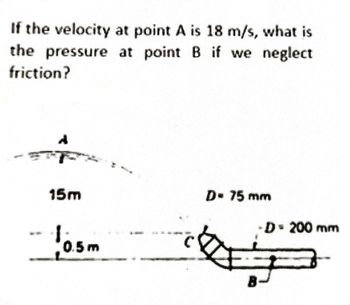
Structural Analysis
6th Edition
ISBN: 9781337630931
Author: KASSIMALI, Aslam.
Publisher: Cengage,
expand_more
expand_more
format_list_bulleted
Question
The final answer should be in 307.9 kPa, kindly show the detailed solution on how it gets done.

Transcribed Image Text:If the velocity at point A is 18 m/s, what is
the pressure at point B if we neglect
friction?
T
15m
☐ 10.5 m
D- 75 mm
D= 200 mm
Expert Solution
This question has been solved!
Explore an expertly crafted, step-by-step solution for a thorough understanding of key concepts.
Step by stepSolved in 2 steps with 4 images

Knowledge Booster
Similar questions
- QUESTION 4 Adding 20ml sample to a 300ml DO bottle causes its dissolved oxygen concentration to decrease by 10 mg/l. by the end of the first day What is the BOD1 of the sample? Answer mg/Larrow_forwardThe diagram below shows a pumping system to pump water to an elevated tank. The next page shows the performance curve of a specific type of centrifugal pump. The loss factors at the inlet and outlet are 0.5 and 1.5 respectively while the loss factor associated with the bend is 1.5. The diameter of the pipe is 0.050 m while the total pipe length is 400 m. In order to simplify the calculation you can assume that the friction factor is f= 0.036. Determine the duty point of this pumping system and thus determine the flow rate of the pump for an impeller diameter of 140 mm? Also determine the shaft power of the pump and give an estimate of the pumps efficiency at the duty point. Given that the pump is located 1.80 m above the water surface (1), and the pipe length from inlet to pump is 6.0 m, determine the NPSHA at the pump and state whether cavitation is likely to occur. Sol: 3.6 m 40 H m 30- P 10 20- K₁ = 0.5 5- kW 2- 1- 13 4 2- NPSH K₁ = 1.5 170 160 150 140. 130_ (1) Q 10 Pump 20 54…arrow_forward18. The results for sieve analysis is shown in the following table: Sieve No. 10 20 40 60 100 % Passing 69.3 59.1 48.3 38.5 28.4 19.8 4.5 Liquid Limit Plastic Limit Non-Plastic (NP) Non-Plastic (NP)arrow_forward
- n h t's Inital Initial | Final EDTA Sample EDTA 2 moles ESTA Volume Ca²+ and Volume Volume Volume Used Mg²+ 100 me 25.0 me 22.9 me 3.1 me 2+ 100 me 25.0 me 21.5m 3.5m 100 me 25.0ml 23.8 me 2.2 m² Sample Water 4 2 3 For each titration: Hardness (ppm) Calculate the average hardness and calculate the standard deviation of your data show sample calculations.arrow_forwardFind the solution to the question in detail with writing the laws used for the extracted values (LF, LS, ES, EF). Thanxarrow_forwardWhat diameter would a circular clarifier have to be to remove 50 μm particles with 75% efficiency from a 4 MGD (million gallon per day) flow? Assume the particle specific gravity is 1.5 and the temperature is 10°C. Answer: 18 marrow_forward
- Directions: Kindly solve numerically what is asked in the following problems using the following techniques: for number 3 (Secant Method-SM). Kindly upload the excel file as your solution file (with proper tabular presentation and highlighted answers of up to 4 decimal places only). Use a tolerance of 0.0005. Initial estimates will be at your discretion.arrow_forwardFigure 1 of 1 Pgas A U h₁ B mercury Part C Assume Patmos = 1.00 atm. What is the gas pressure Pgas? Express your answer in pascals to three significant figures. Ο ΑΣΦ Pgas h₂ Submit Hints My Answers Give Up Review Part Incorrect; Try Again; 2 attempts remaining ? Paarrow_forwardA manufacturer of small appliances purchases plastic handles for coffeepots from an outside vendor. If a handle is cracked, it is considered defective and must be discarded. A large shipment of plastic handles is received. The proportion of defective handles p is of interest. How many handles from the shipment should be inspected to estimate p to within 0.09 with 95% confidence? (Round your answer up to the nearest whole number.) USE SALT handlesarrow_forward
- A river water was taken for analysis. The results for anions and cations analysis are shown below, 165 mg/l 70 mg/l HCO, 2+ Ca Са 173 mg/l 30 mg/1 SO42 2+ Mg 202 mg/l 125 mg/l ci Na Determine and justify either the analysis is acceptable or not. II II IIarrow_forwardI need the answer as soon as possiblearrow_forward1. A nurse applies a force of 4.40 N to the piston of a syringe. The piston has an area of 6.56 x 105 m². What is the pressure increase in the fluid within the syringe? kPaarrow_forward
arrow_back_ios
arrow_forward_ios
Recommended textbooks for you

 Structural Analysis (10th Edition)Civil EngineeringISBN:9780134610672Author:Russell C. HibbelerPublisher:PEARSON
Structural Analysis (10th Edition)Civil EngineeringISBN:9780134610672Author:Russell C. HibbelerPublisher:PEARSON Principles of Foundation Engineering (MindTap Cou...Civil EngineeringISBN:9781337705028Author:Braja M. Das, Nagaratnam SivakuganPublisher:Cengage Learning
Principles of Foundation Engineering (MindTap Cou...Civil EngineeringISBN:9781337705028Author:Braja M. Das, Nagaratnam SivakuganPublisher:Cengage Learning Fundamentals of Structural AnalysisCivil EngineeringISBN:9780073398006Author:Kenneth M. Leet Emeritus, Chia-Ming Uang, Joel LanningPublisher:McGraw-Hill Education
Fundamentals of Structural AnalysisCivil EngineeringISBN:9780073398006Author:Kenneth M. Leet Emeritus, Chia-Ming Uang, Joel LanningPublisher:McGraw-Hill Education
 Traffic and Highway EngineeringCivil EngineeringISBN:9781305156241Author:Garber, Nicholas J.Publisher:Cengage Learning
Traffic and Highway EngineeringCivil EngineeringISBN:9781305156241Author:Garber, Nicholas J.Publisher:Cengage Learning


Structural Analysis (10th Edition)
Civil Engineering
ISBN:9780134610672
Author:Russell C. Hibbeler
Publisher:PEARSON

Principles of Foundation Engineering (MindTap Cou...
Civil Engineering
ISBN:9781337705028
Author:Braja M. Das, Nagaratnam Sivakugan
Publisher:Cengage Learning

Fundamentals of Structural Analysis
Civil Engineering
ISBN:9780073398006
Author:Kenneth M. Leet Emeritus, Chia-Ming Uang, Joel Lanning
Publisher:McGraw-Hill Education


Traffic and Highway Engineering
Civil Engineering
ISBN:9781305156241
Author:Garber, Nicholas J.
Publisher:Cengage Learning